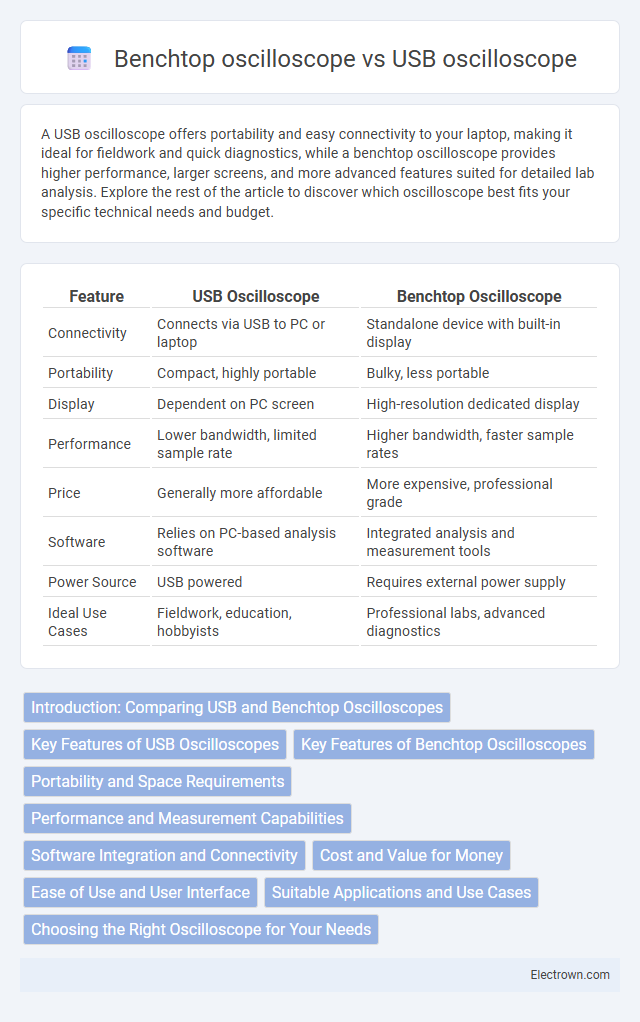A USB oscilloscope offers portability and easy connectivity to your laptop, making it ideal for fieldwork and quick diagnostics, while a benchtop oscilloscope provides higher performance, larger screens, and more advanced features suited for detailed lab analysis. Explore the rest of the article to discover which oscilloscope best fits your specific technical needs and budget.
Table of Comparison
| Feature | USB Oscilloscope | Benchtop Oscilloscope |
|---|---|---|
| Connectivity | Connects via USB to PC or laptop | Standalone device with built-in display |
| Portability | Compact, highly portable | Bulky, less portable |
| Display | Dependent on PC screen | High-resolution dedicated display |
| Performance | Lower bandwidth, limited sample rate | Higher bandwidth, faster sample rates |
| Price | Generally more affordable | More expensive, professional grade |
| Software | Relies on PC-based analysis software | Integrated analysis and measurement tools |
| Power Source | USB powered | Requires external power supply |
| Ideal Use Cases | Fieldwork, education, hobbyists | Professional labs, advanced diagnostics |
Introduction: Comparing USB and Benchtop Oscilloscopes
USB oscilloscopes offer compact, portable solutions ideal for fieldwork and basic diagnostics, while benchtop oscilloscopes provide higher bandwidth, advanced features, and superior signal accuracy suited for detailed lab analysis. Your choice depends on the need for mobility versus precision, as benchtop models often support more extensive channels and complex triggering capabilities. USB oscilloscopes connect directly to a computer, leveraging software for data visualization, whereas benchtop devices operate standalone with integrated interfaces.
Key Features of USB Oscilloscopes
USB oscilloscopes offer compact design and portability, making them ideal for fieldwork and space-constrained labs. Key features include direct PC connectivity for real-time data analysis, multiple-channel inputs, and software-based triggering and measurement capabilities. These devices typically provide lower cost and easier upgrades compared to traditional benchtop oscilloscopes, which excel with larger displays, higher bandwidths, and standalone operation.
Key Features of Benchtop Oscilloscopes
Benchtop oscilloscopes offer superior bandwidth capabilities, often exceeding 1 GHz, enabling precise analysis of high-frequency signals. They feature larger, high-resolution displays with advanced triggering options and multiple input channels, supporting complex waveform analysis. Enhanced signal processing, extensive connectivity including LAN and USB ports, and rugged construction make benchtop oscilloscopes ideal for in-depth diagnostics and laboratory environments.
Portability and Space Requirements
USB oscilloscopes offer exceptional portability and require minimal space, making them ideal for fieldwork and small workstations. Benchtop oscilloscopes, while typically providing more advanced features, demand a dedicated workspace and are less convenient for on-the-go use. Your choice hinges on whether ease of transport or comprehensive functionality is the priority.
Performance and Measurement Capabilities
Benchtop oscilloscopes generally offer superior performance and advanced measurement capabilities, including higher bandwidths up to several GHz, greater sample rates exceeding multiple GS/s, and extensive built-in analysis functions ideal for complex signal diagnostics. USB oscilloscopes provide portable and cost-effective solutions with moderate bandwidths typically up to a few hundred MHz and lower sample rates, suitable for basic to intermediate testing scenarios. The choice depends on the precision requirements, with benchtop models excelling in high-resolution multi-channel measurements and USB oscilloscopes favoring convenience and ease of integration with PC-based tools.
Software Integration and Connectivity
USB oscilloscopes offer superior software integration with direct connection to PCs through USB ports, enabling easy data transfer, remote control, and advanced analysis using versatile software applications. Benchtop oscilloscopes typically provide multiple connectivity options such as LAN, GPIB, and USB, supporting standalone operation and networked environments but often rely on proprietary software that may limit integration flexibility. The choice between the two depends on the need for portability and seamless software workflow versus comprehensive standalone functionality and broader connectivity.
Cost and Value for Money
USB oscilloscopes typically offer a more cost-effective solution with lower upfront investment, making them ideal for hobbyists and small labs seeking good value for money. Benchtop oscilloscopes provide higher performance, advanced features, and greater measurement precision, justifying their higher price for professional and industrial applications. Your choice depends on balancing budget constraints with the need for specialized functionality and accuracy.
Ease of Use and User Interface
USB oscilloscopes offer a compact design with software-based interfaces that integrate directly with your computer, providing customizable displays and automated measurement tools for ease of use. Benchtop oscilloscopes feature dedicated hardware controls and larger screens, allowing for intuitive operation and quick access to advanced functions without relying on external devices. Your choice depends on whether you prioritize portability and software flexibility or tactile controls and standalone convenience.
Suitable Applications and Use Cases
USB oscilloscopes excel in portable diagnostics, fieldwork, and embedded system testing due to their compact size and USB interface for easy laptop connectivity. Benchtop oscilloscopes are ideal for complex signal analysis, education, research, and industrial applications requiring higher bandwidth, multiple channels, and advanced triggering options. Your choice depends on whether mobility or advanced functionality is the priority for your specific measurement tasks.
Choosing the Right Oscilloscope for Your Needs
USB oscilloscopes offer portability and easy connection to your laptop, making them ideal for fieldwork and compact setups, while benchtop oscilloscopes provide higher bandwidth, more advanced features, and larger displays suitable for detailed analysis and demanding lab environments. Your choice should depend on required bandwidth, channel count, and measurement capabilities, with USB scopes excelling in convenience and benchtop models leading in performance and durability. Prioritize your application's precision needs and workspace constraints to select the optimal oscilloscope for accurate signal visualization.
USB oscilloscope vs Benchtop oscilloscope Infographic

 electrown.com
electrown.com